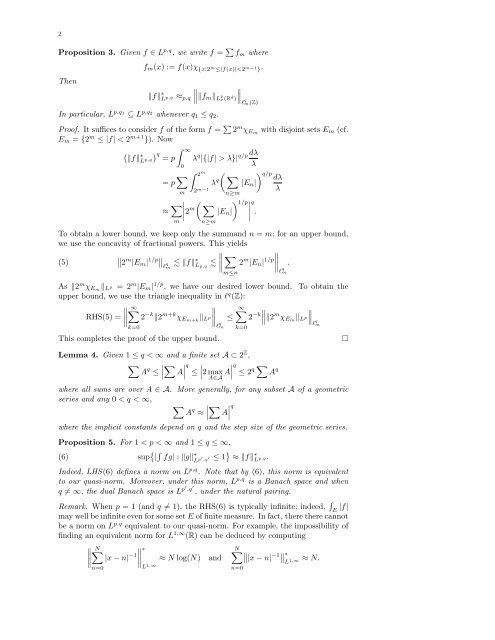247A Notes on Lorentz spaces Definition 1. For 1 ≤ p < ∞ and f : R ...
247A Notes on Lorentz spaces Definition 1. For 1 ≤ p < ∞ and f : R ...
247A Notes on Lorentz spaces Definition 1. For 1 ≤ p < ∞ and f : R ...
Create successful ePaper yourself
Turn your PDF publications into a flip-book with our unique Google optimized e-Paper software.
2<br />
Propositi<strong>on</strong> 3. Given f ∈ L p,q , we write f = fm where<br />
Then<br />
fm(x) := f(x)χ {x:2 m <strong>≤</strong>|f(x)| λ}|<br />
2 m<br />
2 m−1<br />
λ<br />
λ q<br />
<br />
<br />
q/p dλ<br />
|En|<br />
λ<br />
n≥m<br />
<br />
<br />
1/pq <br />
|En| .<br />
n≥m<br />
To obtain a lower bound, we keep <strong>on</strong>ly the summ<strong>and</strong> n = m; for an upper bound,<br />
we use the c<strong>on</strong>cavity of fracti<strong>on</strong>al powers. This yields<br />
<br />
2 m |Em| 1/p q f ℓm ∗ Lp,q <br />
<br />
<br />
<br />
2 m |En| 1/p<br />
<br />
<br />
(5)<br />
.<br />
m<strong>≤</strong>n<br />
As 2 m χEm L p = 2m |Em| 1/p , we have our desired lower bound. To obtain the<br />
upper bound, we use the triangle inequality in ℓq (Z):<br />
<br />
<strong>∞</strong><br />
RHS(5) = <br />
2 −k 2 m+k <br />
<strong>∞</strong><br />
χEm+kLp <strong>≤</strong> 2 −k<br />
<br />
<br />
k=0<br />
ℓ q m<br />
k=0<br />
ℓ q m<br />
<br />
<br />
2 m χEmLp q<br />
ℓm This completes the proof of the upper bound. <br />
Lemma 4. Given 1 <strong>≤</strong> q < <strong>∞</strong> <strong>and</strong> a finite set A ⊂ 2Z ,<br />
<br />
q <br />
<br />
<br />
A <strong>≤</strong> A<br />
q <br />
<br />
<strong>≤</strong> 2 max<br />
A∈A A<br />
<br />
<br />
q<br />
<strong>≤</strong> 2 q A q<br />
where all sums are over A ∈ A. More generally, for any subset A of a geometric<br />
series <strong>and</strong> any 0 < q < <strong>∞</strong>,<br />
<br />
q <br />
A ≈ <br />
<br />
A<br />
q<br />
where the implicit c<strong>on</strong>stants depend <strong>on</strong> q <strong>and</strong> the step size of the geometric series.<br />
Propositi<strong>on</strong> 5. <strong>For</strong> 1 < p < <strong>∞</strong> <strong>and</strong> 1 <strong>≤</strong> q <strong>≤</strong> <strong>∞</strong>,<br />
(6)<br />
sup | fg| : g ∗<br />
L p′ ,q ′ <strong>≤</strong> 1 ≈ f ∗ L p,q.<br />
Indeed, LHS(6) defines a norm <strong>on</strong> Lp,q . Note that by (6), this norm is equivalent<br />
to our quasi-norm. Moreover, under this norm, Lp,q is a Banach space <strong>and</strong> when<br />
q = <strong>∞</strong>, the dual Banach space is Lp′ ,q ′<br />
, under the natural pairing.<br />
Remark. When p = 1 (<strong>and</strong> q = 1), the RHS(6) is typically infinite; indeed, <br />
E |f|<br />
may well be infinite even for some set E of finite measure. In fact, there there cannot<br />
be a norm <strong>on</strong> Lp,q equivalent to our quasi-norm. <strong>For</strong> example, the impossibility of<br />
finding an equivalent norm for L1,<strong>∞</strong> (R) can be deduced by computing<br />
<br />
N<br />
<br />
|x − n| −1<br />
∗<br />
<br />
N <br />
<br />
≈ N log(N) <strong>and</strong> |x − n| −1 ∗<br />
L1,<strong>∞</strong> ≈ N.<br />
n=0<br />
L 1,<strong>∞</strong><br />
n=0
















